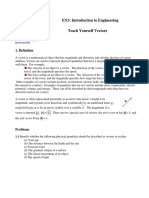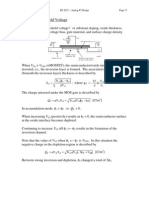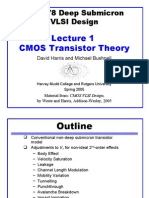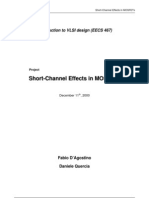MOSFET Device Operation: Accumulation
MOSFET Device Operation: Accumulation
Uploaded by
Mohit SoodCopyright:
Available Formats
MOSFET Device Operation: Accumulation
MOSFET Device Operation: Accumulation
Uploaded by
Mohit SoodOriginal Title
Copyright
Available Formats
Share this document
Did you find this document useful?
Is this content inappropriate?
Copyright:
Available Formats
MOSFET Device Operation: Accumulation
MOSFET Device Operation: Accumulation
Uploaded by
Mohit SoodCopyright:
Available Formats
EE 4253/6253 Lecture Notes
September 7, 1998
page 38
MOSFET Device Operation
ACCUMULATION polysilicon gate silicon dioxide insulator
VGS << VT
p-substrate
DEPLETION
depletion region VGS VT
INVERSION
inversion region (n-type) depletion region VGS > VT
Enhancement-mode nMOS transistor cross-section Holes are repelled from the gate by positive VGS (nMOSFET) At the onset of INVERSION, electrons attracted under the gate to form channel. For a depletion-mode nMOS, area under gate is actually a lightly doped n-type material so that threshold voltage is < 0V.
EE 4253/6253 Lecture Notes
September 7, 1998
page 39
MOSFET Structure versus Bias
Source
n+
Drain 0V Gate
n+
(a)
p-substrate
VGS > VT, VDS = 0V depletion region VDS
n+ n+
inversion layer
(b)
p-substrate
VDS < VGS - VT (Nonsaturated mode) VGS - VT VDS "Pinch-off" VDS
n+ n+
(c)
p-substrate
VDS > VGS - VT VDS (Saturated mode)
Cross-section (a): potential in channel same everywhere because VGS = VGD , channel "depth" same everywhere since VGS > VT and VGD > VT Cross-section (b): Depth of channel varies somewhat linearly with VGS and VDS. As VDS is increased, the drain-side of channel (just beneath the gate) becomes "pinched" because VGD becomes less and less. Cross-section (c): Here the current depends only on VGS and not VDS (if we neglect channel-length modulation) and the channel becomes completely pinched-off near the drain. With VDS > VGS -VT but VS = 0V, then VD > VG - VT and hence, VT > VGD , i.e., Vgate-to-drain is less than the threshold voltage. How does conduction occur after "pinch-off"? Electrons enter channel from source, then are swept across depletion region near drain by the positive drain voltage with respect to source (VDS).
EE 4253/6253 Lecture Notes
September 7, 1998
page 40
MOSFET Threshold Voltage
VT = VT-MOS + Vfb (VT-MOS is positive for nMOS, negative for pMOS)
VT-MOS ideal threshold voltage for a MOS capacitor (the capacitor formed between the gate and substrate) Vfb Flatband voltage Qb VT-MOS = 2b + C b = (Note: "Qb" sometimes referred to as "Qbo")
ox
kT NA q ln ni bulk Fermi potential
o x Cox = oxide capacitance, inversely proportional to oxide thickness C ox = tox Qb = b 2 si . q . N A . 2 bulk charge term (total charge stored in depletion layer), p-substrate in this case
Bulk potential potential difference between Fermi level in intrinsic semiconductor and Fermi level in doped semiconductor Fermi level is the average energy level in a material. For intrinsic materials, it is halfway between the valence band and conduction band. p-type Fermi level closer to valence band n-type Fermi level closer to conduction band Other Constants (see text for values): k = Boltzmann's constant (eV/K, J/K) q = Electronic charge (coulombs) T = temperature (K) NA = carrier density in doped semiconductor ni = intrinsic carrier concentration in Silicon si = permittivity of Silicon = r . o r =11.7 (relative Silicon permittivity) o (permittivity of free space)
EE 4253/6253 Lecture Notes
September 7, 1998
page 41
MOSFET Threshold Voltage (continued)
Qfc Vfb = ms - C
ox
(ms = gate work function, Qfc sometimes referred to as Qss)
Qfc fixed charge due to surface states which arise due to imperfections in silicon oxide interface and doping ms gate work function which is the work function difference between the gate material and substrate
Eg ms = - 2q + b
Eg Bandgap energy of Silicon (temperature dependent) b bulk Fermi potential Note: Eg is actually in electron volts, 1eV = 1q . 1V, so "q" 's in ms expression cancel out.
EE 4253/6253 Lecture Notes
September 7, 1998
page 42
Two common techniques for increasing the native threshold voltage of a MOS device: (1) Vary the doping concentration at the silicon-insulator interface through ion implantation (in process step called "threshold adjustment") affects Qfc (Qss, surface state charge) (2) Use different insulating material for gate affects Cox Between transistors, use very thick oxide (>> tox) to increase threshold voltage so that substrate surface does not become inverted through normal circuit voltage (obviously you do not want signal wire voltages and VD D lines inverting substrate). This keeps transistors electronically isolated from each other. Example VT calculation: Calculate the native threshold voltage for an ntransistor at 300K for a process with a Si substrate with NA = 1.80 10-16cm-3, a SiO2 gate oxide with thickness 200. (Assume ms = -0.9V, Qfc = 0C.) 1.80 10-16 b = 0.02586 ln 1.45 10 1 0 = 0.36V; kT note q = 0.02586V @ T = 300K
with 3.98.8510-14 Farads -7 - 5 = 1.726 10 0.2 10 cm2
Cox =
resulting in
VT = ms +
b + 2 2siqNA2
Cox
b = (-0.9 + 0.384 + 0.72)V = 0.16V
This device has a very low threshold voltage.
EE 4253/6253 Lecture Notes
September 7, 1998
page 43
Substrate (bulk) bias effect on Threshold Voltage
For nMOS, substrate usually tied to ground. However, if V SB (source-to-bulk) 0V, the threshold equations become: VT = Vfb + 2b + VT = VTO +
|) 2siqNA(2b + |VSB
Cox
( 2 b + |V S B | - b ) 2
where VTO is threshold voltage when VSB = 0V and is a constant which describes substrate bias effect. tox 1 = A = C A 2siqN 2siqN ox ox Values of usually range from (0.4 to 1.2)V1/2. In SPICE, = GAMMA, VTO = VTO, NA = NSUB, s = 2b is PHI. Example of substrate bias effect on threshold voltage: With NA = 31016cm-3, tox = 200, ox = 3.98.8510 -14 F/cm, si = 11.78.8510 -14 F/cm, and q = 1.610-19Coulomb 0.210-5 = 3.98.8510-14 = 0.57V1/2 21.610-1911.78.8510-1431016 31016 b = 0.02586 ln 1.51010 = 0.375V At a VSB = 2.5V, VT = VTO + 0.57( + 0.75) 0.75 + 2.5 VT = VTO + 0.53V
In analog designs it is quite common to use substrate bias to shift threshold voltage.
EE 4253/6253 Lecture Notes
September 7, 1998
page 44
Note: When connecting devices in series, VT of top device will increase if VB tied to appropriate rail because VSB is not zero.
VDD Mn2 d2 b2 s2 Mn1 d1 b1 VSB1 = 0V s1 Mp2 d2 VTn2 > VTn1 s2 b2 VSB2 0V Mp1 d1 VTp2 < VTp1 VBS2 0V s1 b1 VBS1 = 0V VDD
Actual shift in threshold voltage due to the above arrangement is very small. ----------------------------------------------------
Revisit operation under Saturation
VGS > VT
G
VDS > VGS - VT
S n+
VGS - VT
D n+
This part of channel is pinched-off because VGD < VT. Current in the induced channel is constant because voltage drop is fixed at VGS - VT. 2 n Ideal equation ID = 2 ( V GS - V Tn ) is not entirely accurate because pinch-off point under gate is influenced by VDS . This influence of VDS on pinch-off essentially modifies the length of the channel (channel length modulation effect).
EE 4253/6253 Lecture Notes
September 7, 1998
page 45
New equation for Saturation
2 ID = 2 (V GS - V Tn ) (1 + V DS )
in SPICE is called LAMBDA, and is the channel length modulation factor. Empirical values range from (0.02 to 0.005) V-1. If we rewrite our current equation as
2 K' W ID = 2 L (V GS - V Tn ) (1 + V DS )
then when > 0V-1, the effective channel length is reduced. Be careful not to confuse channel length with gate length. In saturated pinch-off, they are not equal!
You might also like
- Indonesian Railway Technical Standard For Track WorkDocument41 pagesIndonesian Railway Technical Standard For Track WorkLatifa Pradipta100% (1)
- Chapter 3 Metal Oxide Semiconductor (MOS)Document64 pagesChapter 3 Metal Oxide Semiconductor (MOS)Jay Chandra Dhar100% (1)
- NMOS FundamentalsDocument71 pagesNMOS FundamentalsManjit KaurNo ratings yet
- Vector Tutorial PDFDocument23 pagesVector Tutorial PDFS Rajesh KumarNo ratings yet
- ARUSlecture7 fm5-1 PDFDocument14 pagesARUSlecture7 fm5-1 PDFEmmaMaemunahNo ratings yet
- Mos ModelsDocument39 pagesMos Modelsch0071No ratings yet
- Threshold Voltage MosfetDocument6 pagesThreshold Voltage MosfetsantoshineepandaNo ratings yet
- MOS Transistor Operation: S/D GateDocument10 pagesMOS Transistor Operation: S/D GateConcetto CantoneNo ratings yet
- Basic MOS Device Physics: Zou Zhige 2007 HUSTDocument62 pagesBasic MOS Device Physics: Zou Zhige 2007 HUSTSHIVA VERMANo ratings yet
- 15 MOSFET Threshold VoltageDocument25 pages15 MOSFET Threshold VoltagetweleNo ratings yet
- Sykt DLYgiu FOINNMDocument34 pagesSykt DLYgiu FOINNMAbhaylholkarNo ratings yet
- 2 Threshold Voltage PDFDocument8 pages2 Threshold Voltage PDFTolias EgwNo ratings yet
- Lec17 MOSFET IVDocument49 pagesLec17 MOSFET IVBlanca MeLendezNo ratings yet
- Solns 6Document13 pagesSolns 6api-3750190No ratings yet
- Lecture 26 29 MISFET PDFDocument51 pagesLecture 26 29 MISFET PDFKapilAgrawalNo ratings yet
- Chapter 2 MOS Transistor TheoryDocument25 pagesChapter 2 MOS Transistor TheoryrasheeenNo ratings yet
- Numerical Part-5 UpdatedDocument18 pagesNumerical Part-5 Updatedshashankmittakola6No ratings yet
- Vlsi Design: Mos TransistorDocument162 pagesVlsi Design: Mos TransistorBasheer V.PNo ratings yet
- Microdevices: Mosfets - Metal Oxide Field Effect Transistors N MosfetDocument11 pagesMicrodevices: Mosfets - Metal Oxide Field Effect Transistors N Mosfetblue7nicoNo ratings yet
- Field Effect TransistorsDocument40 pagesField Effect TransistorsRatanNo ratings yet
- The MOS Capacitor: N Polysilicon Gate Gate Oxide 3.9 0Document10 pagesThe MOS Capacitor: N Polysilicon Gate Gate Oxide 3.9 0VLSI_IITRNo ratings yet
- AssignmentDocument120 pagesAssignmentATHIRA V RNo ratings yet
- MIT Subthreshold OperationDocument29 pagesMIT Subthreshold Operationsanjeevsoni64No ratings yet
- Bakir Chapter5Document91 pagesBakir Chapter5mehtajay1993No ratings yet
- Lecture 2 Revision MOSFET Operation and ModellingDocument35 pagesLecture 2 Revision MOSFET Operation and ModellingDominiqueNo ratings yet
- PS3 SolutionsDocument7 pagesPS3 SolutionsMs RasekhNo ratings yet
- MOS PPTDocument13 pagesMOS PPTRenju TjNo ratings yet
- Numerical Part 5Document16 pagesNumerical Part 5r170176No ratings yet
- Mos Transistor Review: 3D Band Diagram of A Long Channel Enhancement Mode NMOS TransistorDocument14 pagesMos Transistor Review: 3D Band Diagram of A Long Channel Enhancement Mode NMOS TransistorKumar Amit VermaNo ratings yet
- Mosfet SDocument25 pagesMosfet SZZZZZ5No ratings yet
- DSM Lecture 1Document57 pagesDSM Lecture 1dmv4mgsNo ratings yet
- Threshold VoltageDocument33 pagesThreshold Voltagemjmanish100% (1)
- Mos Operating Modes & Regions: By-Bhushan MDocument23 pagesMos Operating Modes & Regions: By-Bhushan MbgskkNo ratings yet
- Lecture09 MOSFET (2) Model DC AnalysisDocument9 pagesLecture09 MOSFET (2) Model DC AnalysisRubén RodriguezNo ratings yet
- ps1Document6 pagesps1huaiqian1997No ratings yet
- Lecture 3Document26 pagesLecture 3Rashid AliNo ratings yet
- Lec32 CMOSImplementation PDFDocument31 pagesLec32 CMOSImplementation PDFBom DangNo ratings yet
- Lect 2 New (Capacitors)Document39 pagesLect 2 New (Capacitors)Vineeth KamisettyNo ratings yet
- Numericals Part 6Document16 pagesNumericals Part 6r170176No ratings yet
- MOS Field-Effect Transistor MOSFETDocument34 pagesMOS Field-Effect Transistor MOSFETFrank WanderiNo ratings yet
- Vlsi Classroom Material (16-Aug-2011)Document37 pagesVlsi Classroom Material (16-Aug-2011)naveensilveriNo ratings yet
- EE42 100 Wb-Lecture17 080213-FDocument35 pagesEE42 100 Wb-Lecture17 080213-FozanistzNo ratings yet
- Mosfet 1Document27 pagesMosfet 1Jadhav BhagavatNo ratings yet
- Lecture 30 24112022Document13 pagesLecture 30 24112022Dhruv ParasharNo ratings yet
- Short Channel EffectsDocument15 pagesShort Channel Effectsgene_palencia100% (1)
- MOS Transistor: Prof. NiknejadDocument24 pagesMOS Transistor: Prof. NiknejadWalidNo ratings yet
- MOS Transistor Theory: OutlineDocument24 pagesMOS Transistor Theory: OutlineCarlos AzevedoNo ratings yet
- HW5 SolutionDocument6 pagesHW5 Solutionanna.heeohNo ratings yet
- Mosfet (Iii) - I-V CharacteristicsDocument11 pagesMosfet (Iii) - I-V Characteristics許博凱No ratings yet
- Fa17-Eee-008 - Asssignment 2Document7 pagesFa17-Eee-008 - Asssignment 2Hammad SattiNo ratings yet
- MOS Rabaey PDFDocument32 pagesMOS Rabaey PDFalamgirNo ratings yet
- Outline: PN Junction and MOS Electrostatics (IV)Document16 pagesOutline: PN Junction and MOS Electrostatics (IV)VISHAL SINGHNo ratings yet
- Static Behavior: Poly N+ N+Document14 pagesStatic Behavior: Poly N+ N+Lan LuoNo ratings yet
- Chap 2 Threshold VoltageDocument20 pagesChap 2 Threshold VoltageratnavaliNo ratings yet
- Mosfet OperationDocument70 pagesMosfet OperationTanmayBangaloreNo ratings yet
- Feynman Lectures Simplified 2C: Electromagnetism: in Relativity & in Dense MatterFrom EverandFeynman Lectures Simplified 2C: Electromagnetism: in Relativity & in Dense MatterNo ratings yet
- Tunnel Field-effect Transistors (TFET): Modelling and SimulationFrom EverandTunnel Field-effect Transistors (TFET): Modelling and SimulationNo ratings yet
- Feynman Lectures Simplified 2B: Magnetism & ElectrodynamicsFrom EverandFeynman Lectures Simplified 2B: Magnetism & ElectrodynamicsNo ratings yet
- Reference Guide To Useful Electronic Circuits And Circuit Design Techniques - Part 2From EverandReference Guide To Useful Electronic Circuits And Circuit Design Techniques - Part 2No ratings yet
- Reference Guide To Useful Electronic Circuits And Circuit Design Techniques - Part 1From EverandReference Guide To Useful Electronic Circuits And Circuit Design Techniques - Part 1Rating: 2.5 out of 5 stars2.5/5 (3)
- Cuadro #01: Registro Histórico Estacion JaénDocument35 pagesCuadro #01: Registro Histórico Estacion JaénRaul LatorracaNo ratings yet
- Compiled FluMach Problems - GROUP6 - BSME31Document58 pagesCompiled FluMach Problems - GROUP6 - BSME31Jhun Briones100% (1)
- Vides & Pamapanin - 2015 NZSEEDocument10 pagesVides & Pamapanin - 2015 NZSEEFernando AdurizNo ratings yet
- Physics X NotesDocument45 pagesPhysics X NotesNomi KhanNo ratings yet
- Characteristic-Mode-Based Improvement of Circularly Polarized U-Slot and E-Shaped Patch AntennasDocument4 pagesCharacteristic-Mode-Based Improvement of Circularly Polarized U-Slot and E-Shaped Patch AntennasAnonymous XZUyueNNo ratings yet
- Dimensional AnalysisDocument51 pagesDimensional AnalysisSiimple Opinion Final100% (1)
- PhysicsDocument10 pagesPhysicsanilawasthi100% (2)
- DynamoDocument28 pagesDynamoChris McLean0% (1)
- HSC Y11 Physics 6 Wave Motion and Sound Waves RevisionDocument9 pagesHSC Y11 Physics 6 Wave Motion and Sound Waves RevisiondarrellsunglinNo ratings yet
- Test Planner-Repeater Course - 2023-2024 - (Phase-03)Document2 pagesTest Planner-Repeater Course - 2023-2024 - (Phase-03)SbjNo ratings yet
- Particle Technology Che Calculations Separation Processes Heat and Mass TransferDocument1 pageParticle Technology Che Calculations Separation Processes Heat and Mass TransferAduchelab AdamsonuniversityNo ratings yet
- Cluster 1 Post Test 2023Document6 pagesCluster 1 Post Test 2023fanchasticommsNo ratings yet
- Thermodynamic Properties of Cyclohexanol and CyclohexanoneDocument9 pagesThermodynamic Properties of Cyclohexanol and CyclohexanoneJunaid JohnsonNo ratings yet
- Important Questions For CBSE Class 12 Physics Chapter 5Document33 pagesImportant Questions For CBSE Class 12 Physics Chapter 5sudhanshu narvekarNo ratings yet
- Chapter 1 - Review Mobile Robot KinematicsDocument23 pagesChapter 1 - Review Mobile Robot KinematicshotrantendatNo ratings yet
- Four Probe MethodDocument3 pagesFour Probe MethodSuyash GuptaNo ratings yet
- Physics Classical Mechanics JeopardyDocument33 pagesPhysics Classical Mechanics JeopardyAmanda DoyleNo ratings yet
- Me 360 Armature DC Motor Transfer FunctionDocument2 pagesMe 360 Armature DC Motor Transfer FunctionArun SukumarNo ratings yet
- MURLIDHAR DESHMUKH@ESSAR COM-5616-analysis - Report PDFDocument2 pagesMURLIDHAR DESHMUKH@ESSAR COM-5616-analysis - Report PDFMurlidhar DeshmukhNo ratings yet
- Measuring InstrumentsDocument23 pagesMeasuring InstrumentsMohanaLakshmi JayaramuNo ratings yet
- Copernicus Center Reports, Vol. 3Document132 pagesCopernicus Center Reports, Vol. 3Copernicus Center for Interdisciplinary StudiesNo ratings yet
- UD Complex 2016 I FractalsDynamicalSystems 2Document19 pagesUD Complex 2016 I FractalsDynamicalSystems 2Gabriel Andres Alzate AcunaNo ratings yet
- Electronic Properties of MaterialsDocument23 pagesElectronic Properties of MaterialsPranoy MukherjeeNo ratings yet
- ISAExpo2004 Stratton VelocityCalculatorDocument11 pagesISAExpo2004 Stratton VelocityCalculatorakhileshkuniyilNo ratings yet
- Chapter 40-Introduction To Quantum PhysicsDocument54 pagesChapter 40-Introduction To Quantum Physicstrandinhquang011No ratings yet
- Lindegrin 2Document39 pagesLindegrin 2Babu NarayananNo ratings yet
- Two Year CRP224 Batches - Paper-1Document17 pagesTwo Year CRP224 Batches - Paper-1DHRUV MISHRANo ratings yet
- 7 - Parts of An AtomDocument14 pages7 - Parts of An Atomprabhjotsaggu1028No ratings yet

























































































